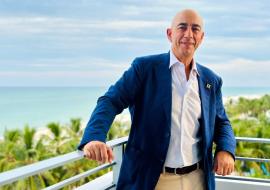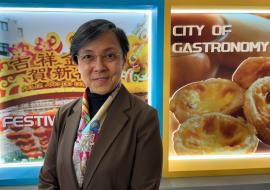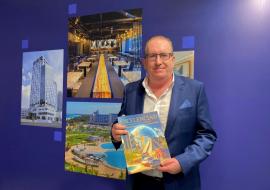Q & A with con Allen Chastanet, St. Lucia’s Tourism Minister
CHA Marketplace 2008 - Bahamas
Allen Chastenet is a seasoned veteran of Caribbean tourism who’s dedicated a considerable part of his life to help the region’s travel industry grow. Now he’s jumped on the public-sector bandwagon and from his position as tourism minister of St. Lucia, Mr. Chastenet is not only advocating for his homeland’s development, but also for the advance of all other Caribbean islands. In this exclusive interview with Caribbean News Digital, Mr. Chastenet -a boldface name in both the CHA and the CTO- spells out his thoughts on a number of hot issues related to tourism in St. Lucia and the Caribbean.
Q.- Alter a long tenure in the private sector, now you’re in the public office. What has this appointment as tourism minister of St. Lucia meant to you?
A.- First of all, it’s been a great honor and during this transition period for St. Lucia, it’s a fantastic time to be on board. We have seven international golf courses under construction in St. Lucia from such legendary names as Jack Nicklaus, Arnold Palmer, Greg Norman and so forth.
In addition to that we have Ritz and Westin that are breaking ground already. We have several other new announcements that we’re making. The government is also embarked on tremendous programs to a thing that’s called “village tourism.” Village tourism is that we have nine fishing villages and we’re now putting small hotels and reorienting the beach fronts so that when people come there, there’re lots of places they can drive around to discover St. Lucia.
For me, it’s been a great transitional period, an exciting time in St. Lucia. (There’s) a lot of growth and we’re getting optimism out of the recognition for the work that we’ve started in St. Lucia.
Q.- Who are the tourists who travel to St. Lucia on a regular basis and where they come from?
A.- Right now about 40 percent of our visitors comes from North America, plus 40 percent that comes from the United Kingdom and Europe, while 20 percent of our visitors comes from other Caribbean islands. And we’re continuing to see that kind of growth. We now have new air access in from the United States, we’re getting new air access from the UK, and we’re now looking to expand and we’ll have a charter coming out of Milan in the wintertime. We’re also looking at Scandinavia, Ireland and also France as our next spots.
Q.- How does St. Lucia assess the chances of both the Spanish and Portuguese markets on the island nation?
A.- We’re very excited about the Spanish market. I think it’s a new partner we’re bringing into St. Lucia. We’re now legalizing gambling, we’re building stores for about a million square feet of shopping space, and the new market is golf, which we think it’s going to help us be able to broaden our base of the kind of tourists that we have. We’re also looking to go into Mexico City, so we’re aggressively going after some of the Spanish-speaking destinations and clearly Spain is very, very high on our list.
Q.- What about the Russian market?
A.- We’re going alter the Russian market and we’re now seeing a lot of Russian investment in the individual villas, so we’re seeing a growing market there, especially in Sandals and other hotels that have been aggressively in that marketplace, so we’re now starting to see that come alive.
Q.- Has your position as tourism minister given you a different outlook, other than the one you had when you were in a private sector?
A.- The cabinet that I’ve got has really been embracing a lot of private-sector initiatives, so I think by me coming in I’ve really been able to help them in that regard. We’re measuring the performance of tourism in a very different way, so we’re looking at the hoteliers as partners and making sure that they’re delivering for us. I think that’s been very refreshing.
Q.- How many hotel rooms are there in St. Lucia right now?
A.- We have about 4,200 rooms and we have presently 2,200 rooms under construction. But it’s a very large destination, it’s 236 square miles, so the goal is to get about 15,000 rooms in the next ten years.
Q.- How many tourists are visiting the island?
A.- Right now we get about 300,000 stayover arrivals and 700,000 cruise ship arrivals, and we’re looking to double that up in the next three years.
Q.- What do you make of Spanish hoteliers trying their hand at the Caribbean islands that are not Spanish-speaking nations?
A.- In Jamaica, in Aruba and in some other places that has been a good thing for those destinations. For us, we’re not looking to really get bigger mass-market properties. St. Lucia is really staying a little bit more on the high-end market, and the cheaper, smaller properties are really trying to keep more domestic and more intimate. I think the Spanish chains have worked very, very well in some of the Caribbean islands, but in our case we’re not looking to go in that direction right now.
Q.- Are you considering the possibility of opening tourism offices in other European countries in the short run?
A.- We’ve just opened up an office in France and a similar office in Germany. As we increase the number of rooms, we’ll start to broaden our representation all throughout Europe.
Q.- How does St. Lucia make a difference when stacked up against other travel destinations in the Caribbean?
A.- I think St. Lucia is lucky and everybody says that because it’s a mixture of all the islands. We’ve got the mountains, we’ve got the beaches, we now have the golf courses, we’ve got small inns, we’ve got bigger hotels. People in St. Lucia have really been absolutely amazing. Whenever you look at the surveys, the ratings that the island gets are really fantastic. We’re a mixture of everything. What’s great is that St. Lucia changed hands between the French and the British fourteen times, so seven times we were British and seven times we were French. There’s colonial air, good music, great vibes. That’s really what you get in St. Lucia; it’s not too small that you get bored fast, and it’s not too big that you feel like you’re getting lost.
Q.- Let’s talk about Sandals. How do you appraise your ties with that hotel chain?
A.- Sandals has been amazing in St. Lucia. St. Lucia has been one of the leading honeymoon destinations for the last fifteen years, and a big part of that has been Sandals. We continue to see Sandals grow in St. Lucia. There’s been major renovations in all Sandals properties in St. Lucia. Flat-screen TVs in the rooms, beautiful restaurants, new beaches, so we’re very, very impressed. They’re about to expand an additional hotel, the Sandals Grand, so we’re very, very excited about what Sandals has done in St. Lucia and they’ve put us on the map in many ways, so we’re very proud of the Sandals products.
Q.- Were you a member of the CHA delegation that traveled to Palma de Majorca to sit down with Spanish hoteliers?
A.- I was supposed to go, but unfortunately I had a very important meeting. Our Prime Minister had died in St. Lucia, so I had to stay for his funeral and I was not able to go, but I was represented by the minister from Aruba. My understanding is that it was a very successful meeting and I really think that the collaboration that may have been missing before with the Spanish chain hotels and helping the Caribbean grow, I think there’s now a better understanding of that. I think that was already put behind us and I look forward to a tremendous relationship with them.
Q.- For a man who’s been so involved in both the CHA and the CTO, how do you see the arrival of this new corporation (CDC) when compared to the former policies that the CHA and the CTO used to have in the past?
A.- CDC is a very important initiative because it allows now both the CHA and the CTO to focus on one plan, so now the CDC is responsible for the marketing of the Caribbean region, which is jointly shared by the private sector and the public sector. It’s very, very important and it has everyone’s support.














